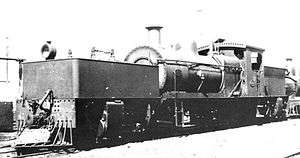Westrail
Westrail was the trading name of the Western Australian Government Railways (WAGR) from September 1975 until December 2000, when the WAGR's freight division and the Westrail name and logo were privatised.
 | |
| Public Authority overview | |
|---|---|
| Formed | 19 September 1975 |
| Preceding Public Authority | |
| Dissolved | 17 December 2000 |
| Superseding agency | |
| Jurisdiction | Western Australia |
| Headquarters | Perth |
| Key document | |
History
The WAGR had its origins in 1879, when the Department of Works & Railways was established.[1] In 1890, the Department was abolished and replaced by the WAGR and the Department of Works & Buildings (later the Public Works Department).[1][2]
In September 1975, the WAGR adopted the trading name Westrail and an associated logo.[3][4][5] However, the official name of the WAGR was not changed.[6]
The new name was the main element of a complete program to improve the WAGR's public image. Every visible feature of the organisation was to be associated with the new Westrail identity. The transition from WAGR to Westrail quickly began, with the new name rapidly and almost universally replacing the old one in the vocabulary of staff and the public.[7]
Strong impetus to acceptance of the new corporate identity was given by the completion of a new Westrail office headquarters and passenger facility at East Perth Terminal (then known as Perth Terminal). The new building, named the Westrail Centre, was opened by the Premier of Western Australia, Sir Charles Court, on 12 November 1976.[8]
Westrail was responsible for managing the state's rail infrastructure.[4] It operated urban and regional passenger and freight services throughout Western Australia. In Perth, Westrail provided the metropolitan area rail service, under contract to another arm of the State government. Its country passenger services involved the operation of both trains and road coaches.[5]
In October 1987, it was announced by Premier Brian Burke and Federal Minister for Land Transport & Infrastructure Support, Peter Duncan, that a merger of Westrail with Australian National was being investigated.[9] Nothing ever came of it.[10]
On 17 December 2000, the WAGR's freight division along with the Westrail name and logo were sold to Australia Western Railroad, a subsidiary of the Australian Railroad Group (ARG).[11] The deal also saw the WAGR's freight lines leased to ARG for 99 years.[12][13]
The WAGR's remaining functions, including owning the rail network and operating regional passenger services,[13] were transferred to the Western Australian Government Railways Commission.[11] On 1 January 2003, the WAGR Commission's functions were absorbed by the Public Transport Authority.[14]
The former Westrail Centre is now known as the Public Transport Centre.[15]
Corporate identity
Initially, Westrail applied an orange with blue stripe livery to its locomotives and passenger vehicles. Freight rolling stock and road trucks were painted yellow, and blue was used on all signs, buildings and printed material. The Westrail logo incorporated a stylised "W" surmounted by a solid bar representing a railway track. Between the bar and the "W" was the word "Westrail".[7]
In July 1997, a yellow with blue livery was unveiled when the first Q class diesel-electric locomotive was delivered.[16]
Publication
From 1975 until 1981, Westrail News Letter was published as a staff newsletter.[17]
References
- "AU WA A580 - Department of Works and Railways". State Records Office of Western Australia. Retrieved 4 June 2018.
- "AU WA A33 - Western Australian Government Railways [1]". State Records Office of Western Australia. Retrieved 4 June 2018.
- "Our history (1950 to 1975 tab)". PTA website. Public Transport Authority. Retrieved 3 February 2014.
- Specialized Container Transport Application for Declarations of Services Provided by Westrail: Recommendations (PDF). Melbourne: National Competition Council. 21 November 1997. p. 4. Retrieved 3 February 2014.
- Productivity Commission (2001). Financial Performance of Government Trading (PDF). Canberra: Performance Monitoring, AusInfo. p. 184. Retrieved 3 February 2014.
- "AU WA A585 - Australian Government Railways (2)". SRO website. State Records Office of Western Australia. Retrieved 4 June 2018.
- Affleck 1978, p. 213
- Affleck 1978, pp. 213–214
- "Profitable merger" Railway Gazette International volume 143 issue 12 December 1987 page 786
- AN-Westrail Integration: An Assessment of Options Bureau of Transport Economics May 1988
- "AU WA A1194 - Western Australian Government Railways Commission". State Records Office of Western Australia. Retrieved 4 June 2018.
- "Australian Railroad Group buys Westrail freight" Railway Digest December 2000 page 23
- Annual Report June 2002 Western Australian Government Railways Commission
- "AU WA A1192 - Public Transport Authority". State Records Office of Western Australia. Retrieved 4 June 2018.
- "About us: Contact us". www.pta.wa.gov.au/ PTA website. Public Transport Authority. Retrieved 7 February 2014.
- "First of Westrail Locos Breaks Cover" Railway Digest August 1997 page 7
- Westrail News Letter National Library of Australia catalogue entry
Bibliography
Affleck, Fred (1978). On Track: The Making of Westrail, 1950–1976. Perth: Westrail. ISBN 978-0-7244-7560-5. OCLC 6489347.

